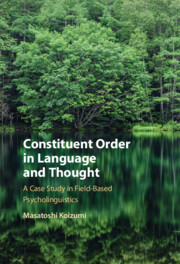Refine search
Actions for selected content:
6584 results in Grammar and Syntax
Tables
-
- Book:
- Korean Grammar
- Published online:
- 16 March 2023
- Print publication:
- 23 March 2023, pp xi-xiv
-
- Chapter
- Export citation
2 - The Grammar of Groups and Phrases in Korean
-
- Book:
- Korean Grammar
- Published online:
- 16 March 2023
- Print publication:
- 23 March 2023, pp 17-108
-
- Chapter
- Export citation
Romanisation
-
- Book:
- Korean Grammar
- Published online:
- 16 March 2023
- Print publication:
- 23 March 2023, pp xxi-xxii
-
- Chapter
- Export citation
Conventions and Abbreviations
-
- Book:
- Korean Grammar
- Published online:
- 16 March 2023
- Print publication:
- 23 March 2023, pp xvii-xx
-
- Chapter
- Export citation
Figures
-
- Book:
- Korean Grammar
- Published online:
- 16 March 2023
- Print publication:
- 23 March 2023, pp ix-x
-
- Chapter
- Export citation
4 - The Grammar of Experiential Meaning in Korean: transitivity
-
- Book:
- Korean Grammar
- Published online:
- 16 March 2023
- Print publication:
- 23 March 2023, pp 180-276
-
- Chapter
- Export citation
Contents
-
- Book:
- Korean Grammar
- Published online:
- 16 March 2023
- Print publication:
- 23 March 2023, pp v-viii
-
- Chapter
- Export citation
Frontmatter
-
- Book:
- Korean Grammar
- Published online:
- 16 March 2023
- Print publication:
- 23 March 2023, pp i-iv
-
- Chapter
- Export citation
Index
-
- Book:
- Korean Grammar
- Published online:
- 16 March 2023
- Print publication:
- 23 March 2023, pp 422-428
-
- Chapter
- Export citation
Preface
-
- Book:
- Korean Grammar
- Published online:
- 16 March 2023
- Print publication:
- 23 March 2023, pp xv-xvi
-
- Chapter
- Export citation
5 - The Grammar of Textual Meaning in Korean: theme
-
- Book:
- Korean Grammar
- Published online:
- 16 March 2023
- Print publication:
- 23 March 2023, pp 277-306
-
- Chapter
- Export citation
1 - Introduction to a Systemic Functional Grammar of Korean
-
- Book:
- Korean Grammar
- Published online:
- 16 March 2023
- Print publication:
- 23 March 2023, pp 1-16
-
- Chapter
- Export citation
6 - The Grammar of Logical Meaning in Korean: clause complexing
-
- Book:
- Korean Grammar
- Published online:
- 16 March 2023
- Print publication:
- 23 March 2023, pp 307-370
-
- Chapter
- Export citation
References
-
- Book:
- Korean Grammar
- Published online:
- 16 March 2023
- Print publication:
- 23 March 2023, pp 415-421
-
- Chapter
- Export citation
7 - Two Applications
-
- Book:
- Korean Grammar
- Published online:
- 16 March 2023
- Print publication:
- 23 March 2023, pp 371-414
-
- Chapter
- Export citation
3 - The Grammar of Interpersonal Meaning in Korean: mood
-
- Book:
- Korean Grammar
- Published online:
- 16 March 2023
- Print publication:
- 23 March 2023, pp 109-179
-
- Chapter
- Export citation

Korean Grammar
- A Systemic Functional Approach
-
- Published online:
- 16 March 2023
- Print publication:
- 23 March 2023

Constituent Order in Language and Thought
- A Case Study in Field-Based Psycholinguistics
-
- Published online:
- 19 January 2023
- Print publication:
- 19 January 2023
Chapter 9 - Word Order Preference in Sentence Production I: Production Frequency
-
- Book:
- Constituent Order in Language and Thought
- Published online:
- 19 January 2023
- Print publication:
- 19 January 2023, pp 86-100
-
- Chapter
- Export citation
Chapter 2 - Kaqchikel Mayan
-
- Book:
- Constituent Order in Language and Thought
- Published online:
- 19 January 2023
- Print publication:
- 19 January 2023, pp 15-22
-
- Chapter
- Export citation
